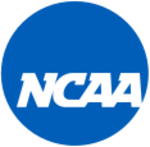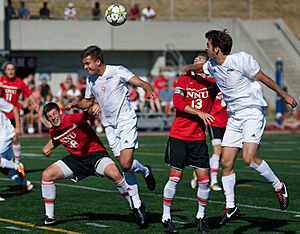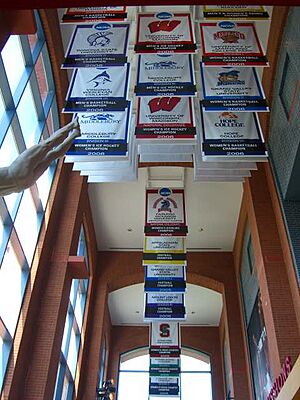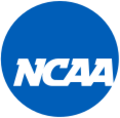National Collegiate Athletic Association facts for kids
 |
|

NCAA's national office in Indianapolis
|
|
| Abbreviation | NCAA |
|---|---|
| Founded | March 31, 1906 in New York City, U.S. |
| Legal status | Association |
| Headquarters | Indianapolis, Indiana, U.S. |
|
Region served
|
United States and one institution in Canada |
|
Membership
|
About 1,100 schools |
|
President
|
Charlie Baker |
|
Main organ
|
Board of Governors |
The National Collegiate Athletic Association (NCAA) is a group that helps manage college sports in the United States. It's a non-profit organization, meaning it doesn't aim to make money for owners. The NCAA works with about 1,100 schools in the U.S. and one in Canada. It helps organize sports programs for colleges and supports over 500,000 student-athletes who play sports every year. The main office is in Indianapolis, Indiana.
Before 1956, all schools in the NCAA were in one group. Then, the NCAA created two groups: the University Division and the College Division. In 1973, they changed to the three-division system we see today: Division I, Division II, and Division III. Schools in Division I and Division II can offer sports scholarships to students. Division III schools cannot offer these scholarships. Generally, larger schools are in Division I, and smaller schools are in Divisions II and III.
In 2006, Division I football was split into two parts: the Football Bowl Subdivision (FBS) and the Football Championship Subdivision (FCS). In the 2022–23 school year, the NCAA made $1.28 billion. Most of this money, about 74%, came from showing the men's basketball tournament on TV.
The NCAA has rules about how much money college athletes can receive from their schools. Some people think these rules are unfair because schools make a lot of money from sports, but athletes don't get paid much. In 2021, the Supreme Court of the United States decided that some of these rules broke U.S. antitrust laws. In May 2024, the NCAA agreed to a settlement that allows schools to pay Division I athletes who have played since 2016.
Contents
- History of the NCAA
- NCAA Headquarters
- How the NCAA is Organized
- Player Rules
- NCAA Sports
- Changes in Sports Programs
- NCAA Championships
- Conferences
- Media Coverage
- Inclusion and Diversity
- College Team Name Changes
- Rules Violations
- Sponsors
- NCAA Finances
- Awards for Athletes
- Other College Sports Groups
- Images for kids
- See also
History of the NCAA
How the NCAA Started
College sports in the U.S. began in 1852 with a rowing race between Harvard and Yale. As more sports like football and basketball became popular, there was a need for rules.
The NCAA officially started because of concerns about injuries and deaths in college football. President Theodore Roosevelt held meetings in the early 1900s to make the game safer. After these meetings, 62 colleges and universities formed the Intercollegiate Athletic Association of the United States (IAAUS) in 1905. This group officially began on March 31, 1906. It changed its name to the NCAA in 1910.
For many years, the NCAA mainly discussed rules. In 1921, it held its first national championship for track and field. More championships, like basketball in 1939, were added over time. After World War II, the NCAA faced challenges, including how to manage new postseason football games and the impact of television on attendance.
Walter Byers became the executive director in 1951. He helped the NCAA grow and set up its first national office in Kansas City, Missouri, in 1952. He also helped create rules for televising football games and managing bowl games.
Changes in the 1970s and 1980s
As college sports grew, the NCAA needed to create different levels for schools. In 1973, schools were divided into three groups: Division I, Division II, and Division III. Five years later, in 1978, Division I football was further split into I-A and I-AA. These were later renamed the Football Bowl Subdivision (FBS) and Football Championship Subdivision (FCS) in 2006.
Before the 1980s, the NCAA did not manage women's sports. Another group, the Association for Intercollegiate Athletics for Women (AIAW), did. In the early 1980s, the NCAA began to offer championships for women's sports. By 1982, all NCAA divisions had national championship events for women's athletics.
The President's Commission
College presidents wanted more control over college sports. In 1984, they formed the President's Commission (PC). This group aimed to improve the academic side of college sports. They focused on things like graduation rates for athletes.
In June 1985, a special meeting was held. Proposals were made to improve academic honesty and require financial checks for sports departments. Most of these ideas passed. Many presidents felt they needed to take responsibility for college sports.
The PC worked for 13 years. They helped make rules about the size of coaching staffs and how much time student-athletes could spend on their sports. They also set higher academic standards for Divisions I and II.
In the 1980s, televised college football became a huge source of money for the NCAA. However, in 1984, the Supreme Court of the United States ruled that the NCAA's control over TV rights was illegal. This decision allowed schools and conferences to make their own TV deals.
Recent Years
In 1999, the NCAA was sued for treating female athletes unfairly under Title IX. The U.S. Supreme Court ruled that the NCAA was not directly subject to that law in this case.
More and more international athletes are joining NCAA schools. For many athletes from Europe, U.S. universities offer a chance to play sports and study at the same time.
In 2009, Simon Fraser University in Canada became the first non-U.S. school to join the NCAA, becoming a Division II member.
In 2014, the NCAA made a record $989 million in revenue. This is one of the highest amounts for a large sports organization.
During the NCAA's annual meeting in 2022, a new version of the organization's rules was approved. This new rulebook is much simpler. It also made the NCAA Board of Governors smaller and gave current and former athletes voting power on the board and within each division. This change means each division can now set its own rules without needing approval from the rest of the NCAA.
Important Court Cases
- In 1951, the NCAA tried to limit how many college football games could be shown live on TV. Some schools, like the University of Pennsylvania, tried to go against this rule.
- In 1984, the U.S. Supreme Court decided that the NCAA's control over TV rights was illegal. This allowed schools and conferences to make their own deals with TV companies.
- In 1998, the NCAA settled a lawsuit with former UNLV basketball coach Jerry Tarkanian. He had sued the NCAA, saying they unfairly targeted him.
- In 2013, a sports analyst named Jay Bilas pointed out that the NCAA was selling jerseys with player numbers but not paying the players. The NCAA then removed these jerseys from its store.
- In 2015, a court ruled that limiting scholarships to the cost of attending a university was fair.
- In 2018, a former UCF kicker, Donald De La Haye, sued his university. His scholarship was taken away because he made money from his YouTube channel. He settled the case so he could finish his degree.
- In June 2021, the U.S. Supreme Court ruled that the NCAA's limits on education-related payments to athletes were illegal. This decision allowed schools to give athletes unlimited money for things connected to their education.
- On July 1, 2021, the NCAA changed its rules. College athletes can now make money from endorsements and sponsorship deals using their name, image, and likeness (NIL). They still need to tell their school about these deals.
- On May 23, 2024, the NCAA and its main conferences agreed to let schools pay players directly for the first time. This agreement settled several lawsuits. The NCAA will pay over $2.7 billion in damages to past and current athletes. Schools can also share up to $20 million per year with their athletes.
NCAA Headquarters
The NCAA's main office moved to Kansas City, Missouri, in 1955. This move was meant to keep the NCAA separate from any single sports conference. The office was near Municipal Auditorium, which hosted many men's basketball Final Four games.
Over the years, the NCAA headquarters moved several times within Kansas City and its suburbs. In 1997, the NCAA looked for a new home. Indianapolis and Kansas City were the final choices. Indianapolis won because it was more central to most member schools. In 1999, the NCAA moved its staff to its current headquarters in Indianapolis, Indiana. Next to the office is the NCAA Hall of Champions, a museum about college sports.
How the NCAA is Organized
The NCAA's main governing body is the Board of Governors. This group chooses the NCAA's president.
The NCAA also has many committees made up of people from its member schools. These committees create rules, which then go to the Management Council for review. Finally, the Board of Directors, made up of school presidents, gives the final approval. The NCAA staff helps by guiding, researching, and handling public relations.
NCAA Presidents
The NCAA didn't have a full-time leader until 1951, when Walter Byers became the executive director. In 1998, the title changed to president.
- Walter Byers 1951–1988 (Executive Director)
- James Frank 1981–1983 (Executive Director)
- Wilford Bailey 1987-88
- Dick Schultz 1988–1993
- Judith Sweet 1991–1993
- Cedric Dempsey 1994–2002
- Myles Brand 2003–2009
- Jim Isch 2009–2010 (interim)
- Mark Emmert 2010–2023
- Charlie Baker 2023–present
NCAA Divisions Over Time
Before 1957, all NCAA sports were in one division. In 1957, the NCAA created two divisions for men's basketball: the University Division (for larger programs) and the College Division (for smaller programs). These names could be confusing.
In 1973, the College Division split into Division II (for schools offering scholarships) and Division III (for schools not offering scholarships). The University Division was renamed Division I. In 1978, Division I football split into I-A and I-AA. These were renamed the Football Bowl Subdivision (FBS) and Football Championship Subdivision (FCS) in 2006.
| Years | Division | ||||
|---|---|---|---|---|---|
| 1906–1957 | None | ||||
| 1957–1972 | University Division (Major Colleges) | College Division (Small Colleges) | |||
| 1973–present | Division I | Division II | Division III | ||
| 1978–2006 | Division I-A (football only) | Division I-AA (football only) | Division I-AAA | ||
| 2006–present | Division I FBS (football only) | Division I FCS (football only) | Division I (non-football) | ||
"National Collegiate" Sports
For some less popular sports, the NCAA holds only one championship for all three divisions. These are called "National Collegiate" championships. Examples include women's bowling, fencing, and skiing. Even if a Division II or III school wins, it's considered a "National Collegiate" title. Division III schools can offer scholarships for these specific sports, but most don't.
Player Rules
The NCAA requires all its athletes to be amateurs. This means they cannot sign contracts with pro sports clubs, earn a salary playing a sport, or work with sports agents.
To play college sports in their first year, students must graduate from high school, complete certain academic courses, and have a good grade-point average (GPA). For Division I, the lowest GPA allowed for a freshman is 2.30.
Students can only play sports for four years. They can take a year off from playing (called "redshirting") without losing a year of eligibility. This means a student has five years from starting college to play four seasons.
NCAA Sports
The NCAA gives out 91 national championships each year: 47 for women, 41 for men, and 3 for coed sports like fencing, rifle, and skiing. The newest sport to become official is women's wrestling, which will have its first championship in the 2025–26 school year. Before that, beach volleyball became official in 2016.
The Football Bowl Subdivision (FBS) of Division I has its own championship, the College Football Playoff, which is not an official NCAA championship.
The NCAA awards championships in many sports, including:
- Basketball
- Baseball (men)
- Track and field
- Softball (women)
- Football (men)
- Cross country
- Field hockey (women)
- Bowling (women)
- Golf
- Fencing (coed)
- Lacrosse
- Soccer
- Gymnastics
- Rowing (women)
- Swimming and diving
- Beach volleyball (women)
- Volleyball
- Ice hockey
- Water polo
- Rifle (coed)
- Tennis
- Skiing (coed)
- Wrestling
| Division I (M) | Division II (M) | Division III (M) | Sport | Division I (W) | Division II (W) | Division III (W) |
|---|---|---|---|---|---|---|
| 1947– | 1968– | 1976– | Baseball | |||
| 1939– | 1957– | 1975– | Basketball | 1982– | 1982– | 1982– |
| Bowling | 2004– | |||||
| 1938– | 1958– | 1973– | Cross country | 1981– | 1981– | 1981– |
| 1941– | Fencing | 1982– | ||||
| Field hockey | 1981– | 1981– | 1981– | |||
| 1978– (FCS) | 1973– | 1973– | Football | |||
| 1939– | 1963– | 1975– | Golf | 1982– | 1996–99; 2000– | 1996–99; 2000– |
| 1938– | 1968–84 | Gymnastics | 1982– | 1982–86 | ||
| 1948– | 1978–84; 1993–99 | 1984– | Ice hockey | 2001– | 2002– | |
| 1971– | 1974–79; 1980–81; 1993– | 1974–79; 1980– | Lacrosse | 1982– | 2001– | 1985– |
| 1980– | Rifle | 1980– | ||||
| Rowing | 1997– | 2002– | 2002– | |||
| 1954– | Skiing | 1983– | ||||
| 1954– | 1972– | 1974– | Soccer | 1982– | 1988– | 1986– |
| Softball | 1982– | 1982– | 1982– | |||
| 1924– | 1964– | 1975– | Swimming & Diving | 1982– | 1982– | 1982– |
| 1946– | 1963– | 1976– | Tennis | 1982– | 1982– | 1982– |
| 1965– | 1985– | 1985– | Track & field (indoor) | 1983– | 1985; 1987– | 1985; 1987– |
| 1921– | 1963– | 1974– | Track & field (outdoor) | 1982– | 1982– | 1982– |
| 1970– | 2012– | Volleyball (indoor) | 1981– | 1981– | 1981– | |
| Volleyball (beach) | 2016– | |||||
| 1969– | Water polo | 2001– | ||||
| 1928– | 1963– | 1974– | Wrestling | 2026– | ||
- The NCAA used to have a boxing championship (1932-1960) and a trampoline championship (1969-1970), but these were stopped.
Emerging Sports for Women
The NCAA also has "Emerging Sports for Women." These sports are growing and might become official championship sports later. Schools can use these sports to meet their required number of sports. The five current Emerging Sports for Women are:
- Acrobatics & tumbling
- Equestrian (Divisions I and II only)
- Rugby
- Stunt
- Triathlon
Women's wrestling was an Emerging Sport but became an official championship sport in January 2025. The NCAA has suggested adding flag football as an Emerging Sport by 2026–27.
Changes in Sports Programs
The popularity of different sports has changed over time. Between 1988 and 2011, NCAA schools added 510 men's teams and 2,703 women's teams.
Men's Sports Changes
Men's sports that grew a lot between 1988 and 2011 include indoor track and field, lacrosse, and cross country. Sports that saw big losses include wrestling and tennis.
| No. | Sport | 1981–82 | 2021–22 | Change | Percent |
|---|---|---|---|---|---|
| 1 | Basketball | 741 | 1,077 | +336 | +45% |
| 2 | Baseball | 642 | 943 | +301 | +47% |
| 3 | Soccer | 521 | 826 | +305 | +59% |
| 4 | Football | 497 | 666 | +169 | +34% |
| 5 | Lacrosse | 138 | 395 | +257 | +186% |
| 6 | Volleyball | 63 | 173 | +110 | +175% |
| 7 | Ice hockey | 130 | 151 | +22 | +17% |
| 8 | Water polo | 49 | 51 | +2 | +4% |
Women's Sports Changes
Women's sports that grew a lot between 1988 and 2011 include soccer, golf, and indoor track and field. No women's sports saw big losses during this time.
| No. | Sport | 1981–82 | 2022–23 | Change | Percent |
|---|---|---|---|---|---|
| 1 | Basketball | 705 | 1,087 | +382 | +54% |
| 2 | Volleyball | 603 | 1,058 | +455 | +75% |
| 3 | Soccer | 80 | 1,035 | +955 | +1193% |
| 4 | Softball | 348 | 986 | +638 | +183% |
| 5 | Lacrosse | 105 | 522 | +271 | +258% |
| 6 | Field hockey | 268 | 286 | +18 | +7% |
| 7 | Rowing | 17 | 146 | +129 | +759% |
| 8 | Ice hockey | 17 | 113 | +96 | +564% |
| 9 | Bowling | 5* | 99 | +94 | +1880% |
| 10 | Beach volleyball | 14* | 91 | +77 | +550% |
| 11 | Water polo | 46* | 66 | +20 | +43% |
| 12 | Acrobatics and tumbling | 27* | 37 | +10 | +37% |
| 13 | Triathlon | 4* | 34 | +30 | +750% |
| 14 | Rugby | 2* | 29 | +27 | +1350% |
| 15 | Stunt | 2* | 2 | - | - |
NCAA Championships

For most NCAA sports, the NCAA gives out gold, silver, and bronze trophies for first, second, and third place. In basketball, both teams that lose in the semifinals get bronze trophies. Winning teams keep these trophies unless they are found to have broken rules.
As of May 30, 2022, Stanford, UCLA, and Southern California (USC) have won the most NCAA championships. Stanford has 131, UCLA has 119, and USC has 111 team championships.
Football Bowl Subdivision Championship
The NCAA has never had an official championship for its highest level of football, Division I FBS. Instead, other groups decide the champion. The winner of the College Football Playoff National Championship gets a trophy, but it's not an official NCAA trophy. The playoff expanded to 12 teams in 2024.
Conferences
The NCAA has three main levels of conferences: Division I, Division II, and Division III. Most schools belong to a main "multisport conference" for most of their sports. However, schools can be in different conferences for different sports. For example, Notre Dame is in the Atlantic Coast Conference for most sports, but its football team is independent.
Division I Conferences
Division I conferences must have at least seven schools and offer at least 12 sports (six for men and six for women).
- American Athletic Conference (The American) *
- America East Conference
- Atlantic 10 Conference (A-10)
- Atlantic Coast Conference (ACC) *
- Atlantic Sun Conference (ASUN) **
- Big 12 Conference (Big 12) *
- Big East Conference
- Big Sky Conference **
- Big South Conference **
- Big Ten Conference (Big Ten or B1G) *
- Big West Conference
- Coastal Athletic Association (CAA)
- Conference USA (CUSA) *
- Horizon League
- Ivy League **
- Metro Atlantic Athletic Conference (MAAC)
- Mid-American Conference (MAC)*
- Mid-Eastern Athletic Conference (MEAC) **
- Missouri Valley Conference (MVC)
- Mountain Pacific Sports Federation (MPSF)
- Mountain West Conference (MW) *
- Northeast Conference (NEC) **
- Ohio Valley Conference (OVC) **
- Pac-12 Conference (Pac-12) *
- Patriot League **
- Southeastern Conference (SEC) *
- Southern Conference (SoCon) **
- Southland Conference **
- The Summit League (The Summit)
- Sun Belt Conference (SBC) *
- West Coast Conference (WCC)
- Western Athletic Conference (WAC) **
- NCAA Division I Independents
Division II Conferences
Division II schools must offer at least five sports for men and five for women (or four for men and six for women).
- California Collegiate Athletic Association (CCAA)
- Central Atlantic Collegiate Conference (CACC)
- Central Intercollegiate Athletic Association (CIAA)
- Conference Carolinas (CC)
- East Coast Conference (ECC)
- Great American Conference (GAC)
- Great Lakes Intercollegiate Athletic Conference (GLIAC)
- Great Lakes Valley Conference (GLVC)
- Great Midwest Athletic Conference (G-MAC)
- Great Northwest Athletic Conference (GNAC)
- Gulf South Conference (GSC)
- Lone Star Conference (LSC)
- Mid-America Intercollegiate Athletics Association (MIAA)
- Mountain East Conference (MEC)
- Northeast-10 Conference (NE-10)
- Northern Sun Intercollegiate Conference (NSIC)
- Pacific West Conference (PacWest)
- Peach Belt Conference (PBC)
- Pennsylvania State Athletic Conference (PSAC)
- Rocky Mountain Athletic Conference (RMAC)
- South Atlantic Conference (SAC)
- Southern Intercollegiate Athletic Conference (SIAC)
- Sunshine State Conference (SSC)
- NCAA Division II Independents
Division III Conferences
Division III schools cannot offer sports scholarships. They must offer at least three team sports for each gender.
- Allegheny Mountain Collegiate Conference (AMCC)
- American Rivers Conference (ARC)
- American Southwest Conference (ASC)
- Atlantic East Conference (AEC)
- Centennial Conference (Centennial)
- City University of New York Athletic Conference (CUNYAC)
- Coast to Coast Athletic Conference (C2C)
- College Conference of Illinois and Wisconsin (CCIW)
- Collegiate Conference of the South (CCS)
- Conference of New England (CNE)
- Empire 8 (E8)
- Great Northeast Athletic Conference (GNAC)
- Heartland Collegiate Athletic Conference (HCAC)
- Landmark Conference (Landmark)
- Liberty League (Liberty)
- Little East Conference (LEC)
- Massachusetts State Collegiate Athletic Conference (MASCAC)
- Michigan Intercollegiate Athletic Association (MIAA)
- Middle Atlantic Conferences (MAC)
- MAC Commonwealth
- MAC Freedom
- Middle Atlantic Conference
- Midwest Conference (Midwest or MWC)
- Minnesota Intercollegiate Athletic Conference (MIAC)
- New England Small College Athletic Conference (NESCAC)
- New England Women's and Men's Athletic Conference (NEWMAC)
- New Jersey Athletic Conference (NJAC)
- North Atlantic Conference (NAC)
- North Coast Athletic Conference (NCAC)
- Northern Athletics Collegiate Conference (NACC)
- Northwest Conference (NWC)
- Ohio Athletic Conference (OAC)
- Old Dominion Athletic Conference (ODAC)
- Presidents' Athletic Conference (PAC)
- Skyline Conference (Skyline)
- Southern Athletic Association (SAA)
- Southern California Intercollegiate Athletic Conference (SCIAC)
- Southern Collegiate Athletic Conference (SCAC)
- State University of New York Athletic Conference (SUNYAC)
- St. Louis Intercollegiate Athletic Conference (SLIAC)
- United East Conference
- University Athletic Association (UAA)
- Upper Midwest Athletic Conference (UMAC)
- USA South Athletic Conference (USA South)
- Wisconsin Intercollegiate Athletic Conference (WIAC)
- NCAA Division III Independents
Media Coverage
The NCAA has deals with TV networks like CBS Sports, ESPN, TNT Sports, and Golf Channel to show its championships. These deals run until the 2031–32 season.
- CBS Sports shows the men's basketball tournament.
- ESPN shows many men's and women's championships, including soccer, football, basketball, and more.
- TNT Sports also shows the men's basketball tournament with CBS Sports.
- NBC and Golf Channel show golf championships.
- Other championships can be watched on NCAA.com.
Westwood One has radio rights for the men's and women's basketball Final Fours and the Men's College World Series (baseball).
From 1998 to 2013, Electronic Arts made college sports video games using the NCAA's name. The NCAA stopped this because of lawsuits about using player images without paying them.
Inclusion and Diversity
The NCAA works to make sure everyone involved in college sports feels included and respected. This includes student-athletes, coaches, and staff from all backgrounds.
NCAA Inclusion Statement
The NCAA believes in and is committed to diversity, inclusion, and fairness for all student-athletes, coaches, and staff. They want to create a welcoming environment where everyone has equal chances. This includes people of different ages, races, genders, backgrounds, and more.
Fairness for All Genders and Title IX
A sports program is considered fair to all genders when both women's and men's sports programs are balanced. Title IX is a law that stops discrimination based on sex. The NCAA provides resources to help schools follow this law and ensure fairness in college sports.
The NCAA also has rules for cities that host championships. These rules say that host cities must protect people from discrimination based on sexual orientation or gender identity. This means everyone involved in an event should be treated fairly.
LGBTQ+ Inclusion
The NCAA has been working to be more welcoming to the LGBTQ+ community. They offer resources to educate colleges and have policies to promote diversity. Title IX also protects transgender people in college sports.
On February 6, 2025, the NCAA changed its policy for transgender athletes. Now, women's sports competitions are limited to athletes who were assigned female at birth.
Race and Ethnicity
The NCAA has policies to protect racial and ethnic minority groups in college sports. They want to increase understanding and address challenges faced by these groups. The NCAA also has rules against hosting championships in states that display the Confederate flag. They also don't allow member schools to use offensive nicknames or mascots based on Native American images.
Student-Athletes with Disabilities
The NCAA helps student-athletes with disabilities by providing special support for their studies and adapted sports. They host championships for adapted track and field, and swimming and diving.
International Student Athletes
More and more international athletes are coming to NCAA schools. For many European athletes, U.S. universities offer a unique chance to play sports and get an education at the same time.
College Team Name Changes
Some colleges have changed their mascots or nicknames because they were seen as based on racist stereotypes, especially those related to Native Americans. While many schools have changed their mascots, some have kept them after getting permission from the Native American tribe they represent.
Here are some colleges that changed their Native American mascots or nicknames:
- Stanford – Indians to Cardinals (1972); became Cardinal in 1981
- UMass – Redmen and Redwomen to Minutemen and Minutewomen (1972)
- Dartmouth – Indians to Big Green (1974)
- Siena – Indians to Saints (1988)
- Eastern Michigan – Hurons to Eagles (1991)
- St. John's (NY) – Redmen to Red Storm (1994)
- Marquette – Warriors to Golden Eagles (1994)
- Miami (OH) – Redskins to RedHawks (1997)
- Seattle – Chieftains to Redhawks (2000)
- Colgate – Red Raiders to Raiders (2001)
- Quinnipiac – Braves to Bobcats (2002)
- Southeast Missouri State – Indians (men) and Otahkians (women) to Redhawks (2005)
- Louisiana–Monroe – Indians to Warhawks (2006)
- Arkansas State – Indians to Red Wolves (2008)
- North Dakota – Dropped Fighting Sioux in 2012; adopted Fighting Hawks in 2015
Some schools, like Utah (Utes) and Florida State (Seminoles), were allowed to keep their names because they have good relationships with the local tribes.
Rules Violations
NCAA member schools promise to follow the rules. If a school is accused of breaking rules, the NCAA investigates. If serious violations are found, the school might be put on "probation." This means they are watched closely and might face other penalties.
In very serious cases, the NCAA can ban a school from playing a sport for a period, which is called the "Death Penalty." This has only happened a few times. The most famous case was Southern Methodist University's (SMU) football team in 1987, which had its season canceled due to many rule violations.
Coaches or staff who break rules can also be given a "show-cause penalty." This makes it very hard for them to get hired by another NCAA school without special permission.
Sponsors
The NCAA has different levels of sponsors. AT&T, Coca-Cola, and Capital One are top-level "Corporate Champions." Other companies are "Corporate Partners."
| Company | Category | Since |
|---|---|---|
| Buffalo Wild Wings | Bar and restaurant | 2015 |
| AT&T | Telecommunications | 2001 |
| Coca-Cola | Non-alcoholic beverages | 2002 |
| GEICO | Insurance | 2018 |
| Capital One | Banking and credit cards | 2008 |
| Nabisco (Ritz and Oreo) | Snack foods | 2017 |
| Hershey's (Reese's) | Confections | 2009 |
| Nissan (Infiniti) | Car & parts | 2010 |
| Wendy's | Fast-food restaurant | 2016 |
| Pizza Hut | Restaurant | 2016 |
| General Motors (Buick) | Car and parts | 2013 |
| Marriott | Hotels and hospitality | 2017 |
| Invesco QQQ | Financial services | 2021 |
| Intuit Turbotax | Tax preparation | 2022 |
| Aflac | Insurance | 2021 |
| Great Clips | Hair Salon | 2020 |
| LG | Consumer electronics | 2021 |
NCAA Finances
The NCAA is a non-profit organization, so it doesn't pay most taxes. In 2014, the NCAA made almost a billion dollars in revenue. Most of this money came from selling TV rights to its sports events. The NCAA also makes money from its investment fund.
How the NCAA Spends Money
The NCAA says most of its money comes from men's basketball TV rights and ticket sales. This money is then given back to schools, conferences, and student-athletes in many ways. In 2017, the NCAA's total revenue was over $1.06 billion. The money is spent on things like:
- Sports Scholarships and Sponsorships: Money given to Division I schools to help fund sports and provide scholarships.
- Basketball Performance Fund: Money given to Division I conferences based on how well their teams do in the men's basketball tournament. This money also helps fund sports and scholarships.
- Championships: Money for team travel, food, and lodging so athletes can compete in championships.
- Student Assistance Fund: Money given to Division I student-athletes for important needs during college.
- Student-Athlete Services: Includes money for injury insurance, drug testing, and leadership programs.
- Equal Conference Fund: Money given equally to Division I basketball conferences that meet certain standards.
- Academic Enhancement Fund: Money for Division I schools to help with academic programs.
- Division II and III Allocations: Funds for championships and other programs for athletes in Divisions II and III.
- Membership Support Services: Covers costs for NCAA committees and meetings.
- Educational Programs: Supports programs like the Women Coaches Academy.
- Other Expenses: Includes legal services and communications.
- General and Administrative Expenses: Funds the daily operations of the NCAA office.
Awards for Athletes
The NCAA gives out many awards to individual athletes, including:
- NCAA Award of Valor: For heroic actions.
- NCAA Gerald R. Ford Award: For leadership in college sports.
- NCAA Inspiration Award: For inspiring actions.
- NCAA Sportsmanship Award: For showing good sportsmanship.
- Theodore Roosevelt Award: The highest honor from the NCAA.
- NCAA Woman of the Year Award: For a senior female athlete who excels in academics, sports, service, and leadership.
- Elite 90 Award: For the student-athlete with the highest grades who reaches the finals of an NCAA championship.
- Silver Anniversary Awards: Honors former student-athletes 25 years after they graduated.
- Today's Top 10 Award: Honors ten outstanding senior student-athletes.
- Walter Byers Scholarship: Honors the top male and female scholar-athletes.
Other College Sports Groups
The NCAA is the biggest college sports group in the U.S., but there are others:
In the United States
- National Association of Intercollegiate Athletics (NAIA)
- National Christian College Athletic Association (NCCAA)
- National Junior College Athletic Association (NJCAA)]] (for two-year colleges)
Groups in Other Countries
- Australia: UniSport Australia
- Canada: U Sports, and Canadian Collegiate Athletic Association (CCAA)
- Philippines: National Collegiate Athletic Association (Philippines) (NCAA), and University Athletic Association of the Philippines (UAAP)
- United Kingdom: British Universities & Colleges Sport
International Group
- International University Sports Federation (FISU)
Images for kids
See also
 In Spanish: National Collegiate Athletic Association para niños
In Spanish: National Collegiate Athletic Association para niños











